Last year, after two cold summers in a row, and our worst tomato harvest ever, we were tempted to throw up our hands, and admit defeat.
Out of sheer desperation this spring we decided that rather than give up on growing our favorite heirloom varieties, we’d try grafting our heirloom plants to disease resistant root stock.
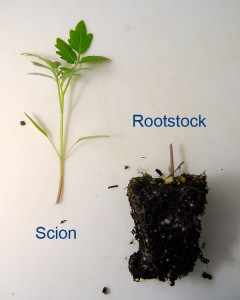
We grafted some of our favorite varieties of heirloom tomatoes to the disease resistant ‘Maxifort’ root stock earlier this spring (click any image to enlarge)
We had experience grafting fruit trees, but the tomato grafting process was somewhat different. We sourced seeds for disease resistant root stock, planted both root and heirloom stock seeds, grafted the plants, and allowed the grafts to heal fully before finally transplanting them out into the garden.
The entire grafting process was more work than simply sowing heirloom seeds directly, and did result in more time required between sowing and transplanting. The question is, was the extra effort worthwhile, and would we do it again?
Initially, at the end of the graft-healing process, we might have thought we were wasting our time.
As you can see above there was a significant difference in the size of the direct sown heirloom plants, versus the grafts, with the grafts being almost half the size.
However, by transplanting time it was clear the grafts were quickly catching up, so once the healing process was complete, their rate of growth appeared to be faster than the conventionally grown plants.
To compare the grafted and non-grafted plants more directly, each grafted tomato variety was planted immediately next to its non-grafted counterpart. This ensured the plants were being grown in the same soil, with the same amount of watering, in the same lighting conditions.
With the tomatoes planted, it was time to wait, and see what the season would yield.
Although disease seemed to be a factor in last year’s poor crop yields, weather was also very much a factor. Weather of course is the one element we have no control over in outdoor plantings.
Fortunately, this year was much warmer, and much sunnier, during the peak of the tomato growing season. We experienced much less persistent coastal fog, and experienced less extremes between cold and heat throughout the growing season.
The improved weather conditions this season meant that even our non-grafted tomatoes this year performed much better than last season. However, there were notable differences between the grafted and conventionally grown stock, including larger overall plant size, more fruit set, and larger fruit size on the grafted plants.
Most of the heirloom varieties grown this year were the same as last year, again because we wanted to see if the poor-performers last year would do better once grafted. As we only started a couple of grafted plants for each variety, there were a couple of varieties were all the grafts failed before transplanting, so we could only grow non-grafted plants, and those are noted below with an asterisk.
Argentina (Mid-Season; Indeterminate)
Very good yields of beautiful pink-colored beefsteak tomatoes. Robust plants with richly flavored, sweet, slightly acid fruits.
Grafted plants were at least twice as fruitful as the non-grafted plants, and consistently produced larger fruits late into the season.
Azoychka (Mid-Season; Indeterminate)
Last year this Russian heirloom variety produced very few fruits, which surprised us as Azoychka is supposed to be more tolerant of our cooler coastal climate. This year, however, Azoychka was one of our best producers.
Fruit set was earlier than some of the other mid-sized varieties. This yellow-orange tomato has a bright, sweet flavor, with modest acidity. Azoychka has relatively little juice, and few seeds, compared to some other varieties of this size, making it an excellent choice for pizza, or crostini.
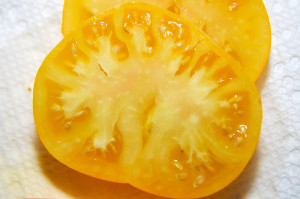
Azoychka is a meaty tomato that’s perfect for use in sandwiches or on pizza as it won’t make crusts too soggy
Beam’s Yellow Pear (Mid-Season; Indeterminate):
This was one of two total crop failures last year (the other was Pineapple). Previously Beam’s Yellow was the stalwart cherry tomato in the garden, but was the first to succumb to wilt last season, long before any fruit could ripen. This year fruits were larger than their non-grafted siblings, yields were higher, and the plants still look good in mid-October.
This season Beam’s produced plenty of sweet, juicy, low-acid fruits, although the non-grafted plants clearly weren’t as productive. Grafting definitely made a difference for this tomato variety this season.
Black Cherry * (Early-Season; Indeterminate)
The grafts failed for Black cherry this spring, so only conventionally grown plants were transplanted.
Overall, despite the improved weather, performance was not much improved over last season. Although the plants did grow better this year, likely due to the improved weather, fruit set and yields were not as good as expected with the improved growing conditions this summer. The fruits were sweet, with a complex, slightly smoky, tomato flavor. Yield-wise though it’s questionable as to whether or not we’ll plant this variety again, although we might try once more if the plants are grafted.
Black Pear (Mid-Season; Indeterminate)
There’s no question that Black Pear performs better with more heat, but even during last season’s cold spell, it was still one of our best producers.
This season there was no question which fruits came from the grafted plants, as you can see below, as fruit size was substantially larger from the grafted plants. The grafts produced excellent yields of heavy fruits, and this is still a farm favorite. Black Pear has a rich, smoky flavor, and is highly crack-resistant.
Blondkopfchen (Mid-Season; Indeterminate)
Last year this yellow cherry tomato produced an absurd number of flowers, but failed to set much fruit. We hoped that the grafted plants would perform much better for us this season, but we were still very disappointed.
Although fruit yields were higher, for a small cherry tomato, overall yield was very low, the lowest of any cherry tomato grown here this season. Although daytime temperatures were better for us this summer, evening temperatures were rarely over 55 degrees, especially in the early to mid-season. The Blondkopfchen plants themselves grew very well, produced masses of blooms, but the cooler evening temperatures seemed to inhibit fruit set.
Now that we’ve tried this variety both conventionally grown, and grafted, with poor results, we won’t grow it here again. The few fruits that were set were quite sweet, and flavorful, but this variety likely would perform better a little further inland where nighttime temperatures are warmer.
Crnkovic Yugoslavian (Late-Season; Indeterminate)
Last year this was one of our poorest producing tomatoes. Fruits were small, not particularly flavorful, and yields were abysmal. What a difference a year makes! This year the fruits were comparatively huge, exquisitely flavored, and Crnkovic was a long season producer.
Despite being classified as a late-season variety, Crnkovic was the first variety to produce ripe fruit after our early-season Stupice. It was also the first to be devoured by the woodland creatures that raided the garden early in the season.
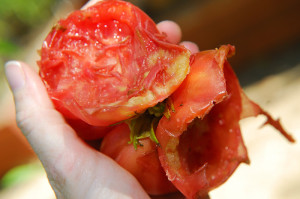
9 out of 10 rodents agree that Crnkovic Yugoslavian is scrumptious…and the bigger, the better (insert the farm wife’s expletive here)
Thankfully though, they left us plenty of unblemished fruit. The slightly flattened pink fruits had green shoulders, and showed no evidence of cracking throughout the season. However, the fruits were so large that the branches tended to collapse under the weight. As such, we may need to reinforce our supports for next season!
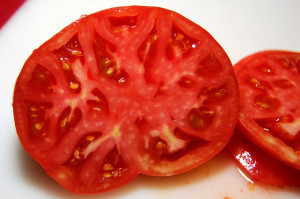
Crnkovic Yugoslavian is juicier, and slightly less meaty than Argentina, but the fruits on average were larger
Juicy, with abundant tomato flavor, Crnkovic Yugoslavian was perfect for salads and sandwiches. There’s no question we’d grow this again.
German Orange Strawberry (Late-Season; Indeterminate)
A few years ago this orange oxheart tomato appeared in a bed of what should have been German Red Strawberry. We’ve successively been saving seed from this variety for the last couple of years though, as it has always produced hefty-sized fruits. Last year, although fruit size was still substantial, yield was low.
This year yield was still very low on the non-grafted plants, but the grafted plants produced a good number of whopping sized fruits!
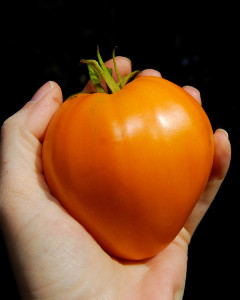
Compare that to the largest one we’d grown previously, before grafting…looks rather puny in comparison
This is still one of our favorite tomatoes that we’ve grown. Bursting with sweet, complex tomato flavor, without being excessively acidic, or too juicy, we use this tomato in everything from salads, to sauces.
Pineapple (Late-Season; Indeterminate)
Last year this popular variety was a total crop failure. This year we now understand what all the fuss is about. We’ve been on a quest for some time for a decent yielding bi-colored tomato, having previously tried Marvel Stripe, and Texas Star.
Pineapple this year produced some of the largest fruits of any variety grown this season, second only to German Orange Strawberry. It’s fair to call this a meaty tomato. Moderately low acid, with good tomato flavor, few seeds, and absolutely gorgeous when cut.
Overall, moderately prone to cosmetic cracking around the shoulders, especially in the largest fruits, but not enough to really detract from the overall appearance of this tomato. The sweet flavor makes it worth it, and we will grow this again.
Russian Persimmon (Mid-Season; Indeterminate)
This has been the farm-favorite variety for years. Last year was the first time this tomato struggled in our garden, but last season was exceptional. We’ve grown Russian Persimmon, and been saving seed, for a number of years now, and we knew that in normal conditions this variety was a dependable, high-yielding, long-season heirloom. This year Russian Persimmon was a breeze to graft, in that the grafts took quickly, with no losses. The conventionally grown plants performed better this year than last, but the grafted plants blew us away. Yields were great, but more impressive was fruit size.
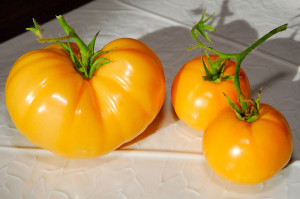
On average, the grafted fruits of Russian Persimmon (left) were at least THREE times bigger than the fruits from non-grafted plants (right)!
I picked these tomatoes this morning. The smaller pair are from the non-grafted plant. The behemoth next to them was from the adjacent grafted plant. The difference between them borders on the absurd! The other notable difference in the plants was that for some reason the grafted Russian Persimmon seemed to produce a lot of foliar growth as well (which is good as the plant had a lot of fruit to support), so it’s a little like going on a treasure hunt among the leaves searching for fruits.
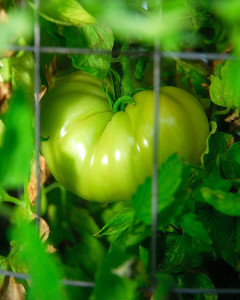
The green fruits this season were hiding among lots of foliage, but fortunately, once ripe, their bright orange color makes them stand out
It’s well worth hunting for them though, as they always liven up any plate of sliced tomatoes, and the flavor, for an orange tomato, is unrivaled in our opinion.
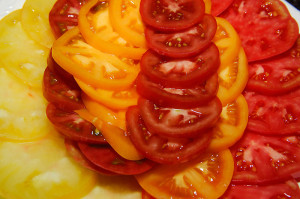
Azoychka (left); alternating Black Pear and Russian Persimmon (center); Crnkovic Yugoslavian (right)
Salisaw Cafe (Early-Season; Indeterminate):
This large red cherry tomato bursts with classic tomato flavor, without being excessively sweet. This is the third year we’ve grown this variety.
The first year performance was excellent, but drastically reduced last season. This season was much better though. Although this is classified as a cherry tomato, Salisaw’s are quite large, often over an inch-and-a-half across, but they’re sweet, and juicy, and almost as prolific as the hybrid Sweet 100…just not as sugary.
San Marzano Lungo No. 2 * (Mid-Season; Semi-Determinate)
Grafts failed for San Marzano prior to transplanting. Last year San Marzano out-performed another paste tomato, Federle, in yield. This season the non-grafted San Marzano plants produced better than last season due to the warmer weather. Fruit yield was higher, and fruits were larger, so it’s unfortunate we didn’t have an opportunity to compare them to grafted plants. There is a strong initial fruit set in the mid-season with this variety, but due its semi-determinate habit, we’re still harvesting a few fruits even in mid-October as the season winds down.
With few seeds, and little juice, these tomatoes are the standard paste-tomato found at Farmer’s Markets in this area. However, we find they’re not overly complex in tomato flavor, so next year we may try Opalka instead, which is reportedly much more flavorful.
Stupice * (Early-Season; Indeterminate)
Grafts failed for Stupice prior to transplanting. This mid-sized Czechoslovakian potato-leaf heirloom is the earliest of our tomatoes to ripen each season. The deep red fruits have that near-perfect balance of tomato flavor and acidity. Apparently they were so good that we must have eaten them before I had a chance to take photographs though! The only complaint I have is that for an indeterminate variety, fruits produced later in the season are more scant, and often significantly smaller than the initial fruit set. In our gardens at least, this variety seems more semi-determinate, like San Marzano. Overall though it’s difficult to beat Stupice here for early season ripe fruits, which are excellent in sandwiches and salads.
Overall, the grafted tomatoes this season far out-performed their non-grafted counterparts, so in answer to “would we do this again”, the answer is a resounding “yes!”…wouldn’t you?
Next spring there are a few things we’ll do differently though.
Without a goat barn to build next spring, we’ll begin the grafting process much earlier in the season to give the plants ample time to heal in time for transplanting in mid-April.
The only grafts we lost happened early in the healing process, while the plants were in the humidity chamber. Although we tried to time grafting for days with cooler day-time highs, it was still very warm in the greenhouse, and some of the grafts struggled to heal without wilting. Grafting earlier, before the weather heats up too much should help improve our grafting success.
It did seem that some varieties, like Russian Persimmon, tolerated the grafting process much better than others, but we were new at this too, so with practice our grafting technique should improve. Just in case though, next year we’ll probably sow more root stock seeds, stagger them over a longer period (to better match scion diameter), and graft a couple extra of each variety as insurance.
Despite being grafted it’s clear that Blondkopfchen is not an ideal variety to grow here with our cool coastal evening temperatures. We may try grafting Black Cherry again next year, or perhaps we’ll try something entirely different. That’s the beauty of tomatoes, there are so many to choose from!
Crnkovic Yugoslavian was the big surprise this season, after last year’s dismal performance, so there’s no question that grafting made all the difference in the world. That said though, none of the grafted plants, with the exception of Blondkopfchen, were disappointing this year, and most performed beyond our expectations.
As you can see, there has been no shortage of tomatoes for sandwiches, or salads…
…grilled summer Margherita pizzas…

My personal favorite, grilled Margherita pizza, with Russian Persimmon, and Argentina tomatoes, fresh mozzarella, and basil
…or quiches….
…or roasted tomato sauce…
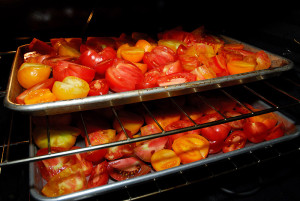
When life gives you too many tomatoes, it’s a perfect excuse to slow roast them, and make heirloom tomato sauce!
As the season draws to a close though, and we scramble to preserve the last of this season’s tomatoes, it will soon be time to start thinking about planning for next season! Do you have a favorite heirloom we should add to our list for next year?

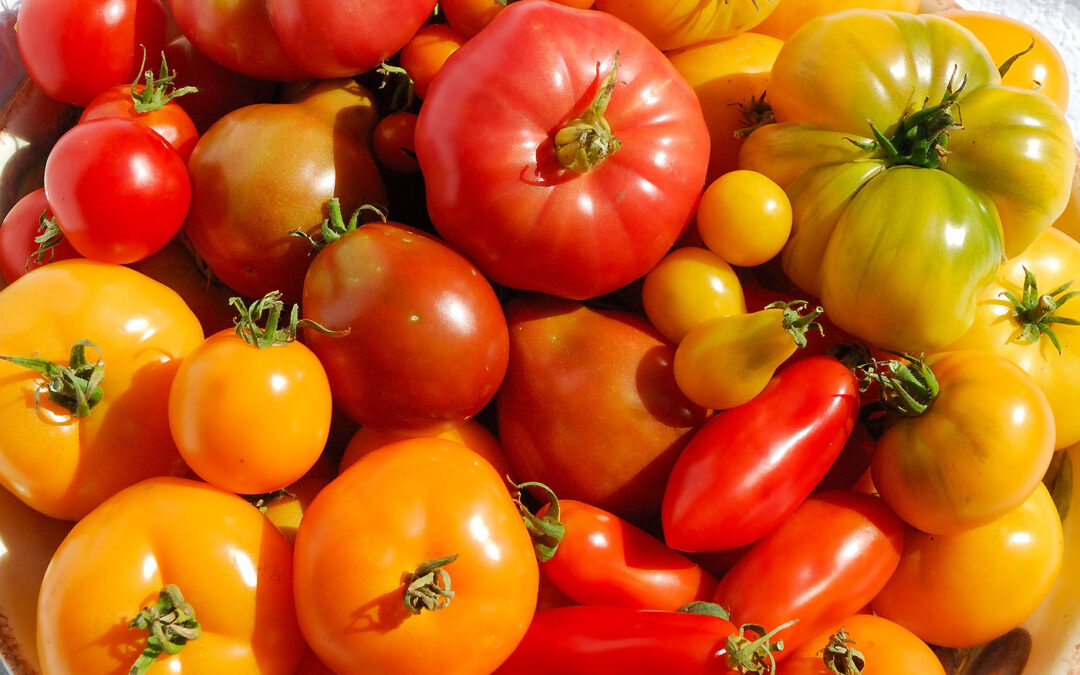


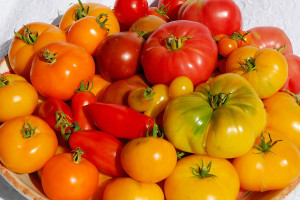
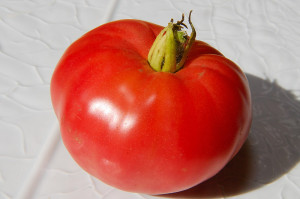


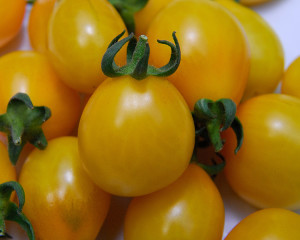
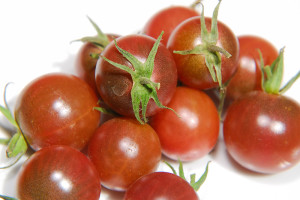

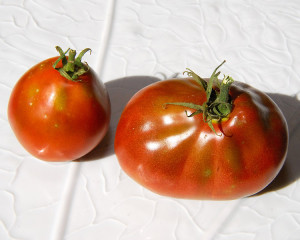
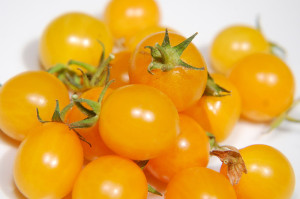
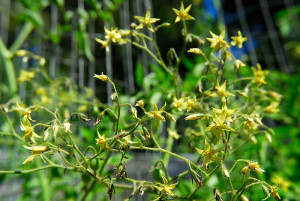
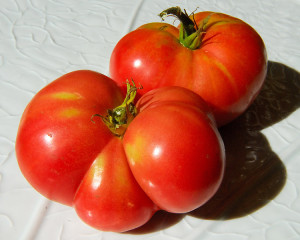
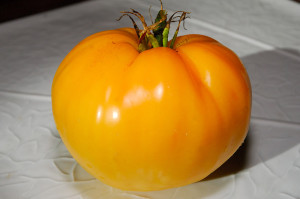
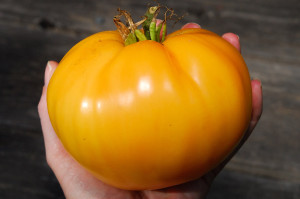
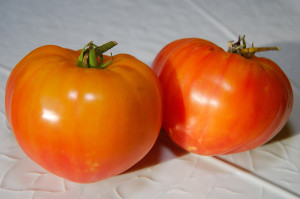
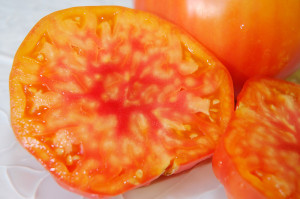
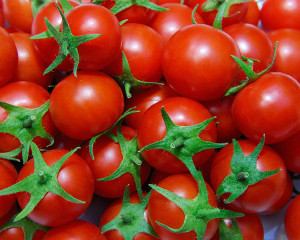
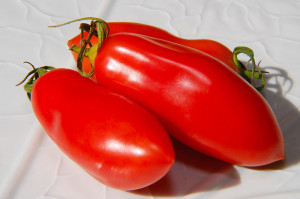
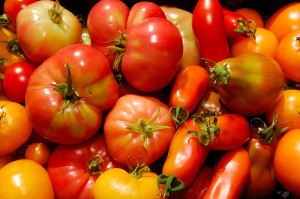
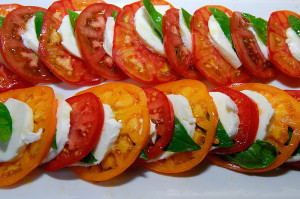
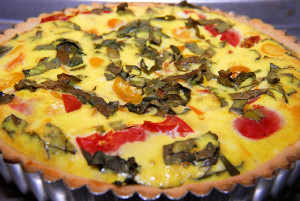







Blondkopfchen failed even more miserably for us, not even making it out of the pot. Thanks for the update on what worked with grafting!
I think your summer temperatures tend to be warmer than us too. I’m not sure why this tomato seems to perform so poorly here. Would love to hear if grows well for anyone. Oh well, thankfully there are many other tomatoes that do very well!
Words fail me. What a great research project, and such beautiful tomatoes. I grew Black Plum tomatoes this year and thought they were my best tomatoes of this year. My Box Car Willie was my best performer, but the German Johnson’s did pretty well too. Lou
Now that we know grafting makes so much difference, next year I’m looking forward to a very productive season. Our goal will be to only plant grafted tomatoes next season. Half the crop this year was direct sown, so next year’s productivity should be even better 🙂
Oh I am so depressed to see this…why? Because I cannot produce heirlooms like this no matter what…the weather and fungal issues defeat us…but I still may try a few just not so many… disease resistant are the only ones we can grow here…I am very happy to see all your hard work has paid off…my hubby wants tomatoes to eat so back to the disease resistant.
There are a lot of areas growing healthy tomatoes can be a challenge. Disease resistance is why we started this project in the first place. Although there are good F1 hybrid cultivars on the market that are inherently disease resistant, we really wanted to confer that resistance to some of our favorite heirlooms, so grafting, for us, is the way to go. However, it is more expense (roughly 50c per plant for root stock seed), and requires more time at the start of the season, so I know that grafting isn’t for every gardener, but for us the results were definitely worth it.
Loved your sense of humor on this! Wow, you have an incredible harvest! Yum! I just had fresh Tomatoes on BLTs tonight–nothing better!
If I didn’t laugh at the devastation in the garden sometimes, I think I’d throw up my hands and cry 😛 I think a sense of humor, when gardening in the presence of voles, gophers, rats, squirrels and their ilk, is required, if only to preserve one’s sanity! 😀
We had a rodent problem, as well, but they only attacked one particular variety. Didn’t touch the others with a 10 foot pole. Odd.
Our rodents here definitely had their favorites, although anything seemed to be fair game in the early season. Later in the summer they focused on the biggest, prettiest specimens, in the garden 😉
Just beautiful! The grafting results are really useful and interesting too. Filed away for future use. 🙂
I’m so looking forward to seeing your edible garden next year!
Hi Clare,
Lovely tomatoes; I’m pleased you’ve had a much better season this year!
My total ripened toms for this year so far is……………………
1.
Oh yes, that was one.
I have some more which are beginning to colour up, they’ve been brought inside for warmth now. That lone little tomato will soon be savoured on a sandwich.
I hope it was worth it.
I’m glad you at least managed to get one 🙁 I bet it will turn out to be the best tomato you’ve ever tasted. I know the weather has been strangely cold and wet there this season. Hopefully next summer will prove to be more fruitful in your garden.
I would have never even thought about grafting tomatoes! What an experiment! But, interesting results. And wow – that German Orange Strawberry is huge!!! You’ve also given me some ideas of new tomato varieties to try.
That German Orange Strawberry was a monster! The scary thing is, there are three others almost as large waiting to ripen! We have had trouble this year with the vines not being strong enough to support fruit that large. We’ll have to be more proactive with supports next season. On the other hand, some of the fruit has been truly impressive, with no sacrifice on flavor. I highly recommend Russian Persimmon, and Black Pear!
That’s amazing, I never would have thought that the grafted plants would actually produce larger fruit. I just thought the plants would be healthier overall. Definitely worked out well for you and what an amazing selection.
I wasn’t expecting larger fruit either. I thought if the plants were healthier that there may be more fruits in total, but the size difference in the fruits on the grafted plants was a surprise!